| |
|
| |
|
|
As a teenager, Terry Hayes got a small start in flying by working
weekends at a local airport. He washed airplanes, changed oil,
gassed them up, carried luggage, biked to the restaurant for
take-outs and, in general, did the grunt work at the airport
in exchange for ten or fifteen minutes of flight instruction
per week. This was what is known in the trade as “touch
and goes.” The student takes off, flies around the square
pattern and lands without stopping – then takes off and
goes around – repeat –.
|
| |
|
|
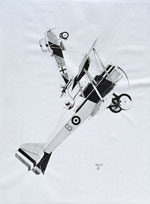
Early
Lithograph
|
In Hayes’ early
school books there are movies of flying airplanes. In the
margins of the pages he drew tiny sketches of airplanes, each a
little different from the one before, rolling or spinning. So that
when released from under the thumb, the flipping pages produced
a tiny sketch of an airplane which appeared, in succession, to
be stunting in a loop, a roll, a spin.
He got his start in commercial art in a large department store,
Maison Blanche, in New Orleans. The art director in the advertising
section, gave him assignments in illustrating ladies’ purses
and shoes, sporting goods and furniture – anything with hard
lines and slick finishes. At home in his spare time he painted
action scenes from World War I aviation, researching particular
paint jobs and serial numbers, everything for authenticity in the
works. He painted over twenty of these and put on a one-man
show, which was written up in the New Orleans Times Picayune newspaper. |
| |
|
|
He got a letter from the editor of the San Francisco Chronicle
a month after the article appeared in the local paper asking,
if Hayes could send some paintings up to him. He would pick up
the tab for the shipping and arrange for the gallery to show
them. Hayes was delighted to accept the offer. The
exhibit turned out tro be a two-man show with World War II paintings
by Alfred Owles, some forty paintings in all, which sold out.
|
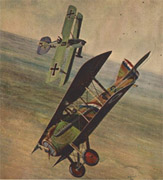 Painting
from the Chronicle Article
Painting
from the Chronicle Article |
| |
|
|
The aviation writer, Ernest K. Gann, bought
two of Hayes’ works,
one of which he sent to his friend, Reed Chambers, an ex World
War I ace and CEO of an insurance firm, in New York, which specialized
in aviation clients. Mr. Chambers invited Hayes to lunch
at the Boston Club and bought one of his paintings, which depicted
an adventure with Eddie Rickenbacker from the famous 94th Squadron. Rickenbacker
was a great fighter and a modest man who contributed vastly to
the airline industry.
|
| |
|
|
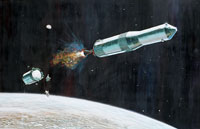 Apollo
Launch - 2nd Stage (NASA)
Apollo
Launch - 2nd Stage (NASA) |
In 1963, the Boeing Company came
to New Orleans to start the Apollo Project, sending a man to the
moon and return. Their appearance
coincided with another show of Hayes paintings downtown in a large
office building. Boeing called him for an interview and hired him
on the spot. For the next two and one-half years he illustrated
Apollo rockets at a handsome salary. |
| |
|
|
Then the Department of Health in New Orleans appealed to the
people to support an effort to control the spread of mosquitoes. The
pests were discouraging to tourists in a major degree. George
Carmichael came to town and spoke of establishing a new department
in the Board of Health and was enthusiastically endorsed by the
people of the city. Hayes was hired as the first pilot
to come to work in the effort. He flew for the next seven
years at that occupation.
Hayes left New Orleans in 1977 to pursue a new career in California. He
settled in Oakland and painted a series of illustrations of the
Reno Air Races. After a one-man show at the Oakland Airport
he moved to San Diego and the Reno series of race scenes was
placed in the Aerospace Museum in Balboa Park where they remain
in the permanent collection.
|
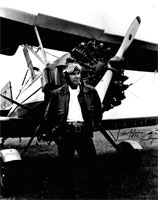
Terry in Front of a Crop Duster Plane |
| |
|
|
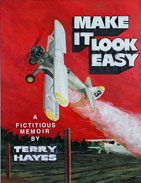
Book Cover |
Hayes wrote a book about his adventures,
a roman a clef, which he titled,
“Make It Look Easy.” It is a fictionalized treatment of his flying
in the Big War and his crop dusting and spraying up until the time he went
to work for the Health Department of New Orleans, attempting to wipe out the
mosquito. View some of Terry's illustrations for "Make it Look Easy" in the
Action section of the site.
Hayes' last body of work features over forty paintings of Landmarks of the
World including the Statue of Liberty, Niagara Falls, the Eiffel Tower, Macchu Pichu,
the wall art of Altamira Cave, Stonehenge, and the Goodyear Blimp (itself a
landmark of the world and a platform from which to observe the other landmarks
depicted in this series.)
|
| |
Landmarks of the World was a breakthrough
in subject matter and style for Hayes. Moving beyond his whimsical and technically precise illustration style, he started using color and forced
perspective to depict iconic landmarks in a manner that causes
the viewer to reconsider their importance and role in world culture.
Hayes strove for
creative breakthroughs; for example, interpreting a sensuality not
previously depicted in representations of the Statue of Liberty. Celestial, terrestrial, architectural, archeological, anthropological and
natural; these were constructs much beloved by Hayes and the deeply abiding inspiration for these ground breaking paintings.
He began work on this series in 2000 and continued painting new pieces through 2011. This series is available for showing by appointment.
|
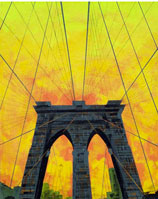
Brooklyn Bridge from the Landmarks series |
| |
|






